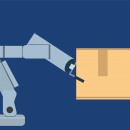
Current Technology Advances in Warehousing
E-commerce was already on the rise before the arrival of Covid -19 but now how we shop has possibly changed forever. This has led to an increase in warehouse space demand and it follows that there is also a rise in companies looking to invest in warehouse technology to ensure they can work at maximum efficiency to deal with customers changing expectations.
The market for warehouse management systems (WMS) is growing. The software, which works in real time can track inventory, direct the movement of materials, let pickers know of orders and be tailored to a company’s specific needs. A trend is moving towards cloud based applications of this software because it is centralised and cheaper than an in-house data centre.
In this current climate the software will also help with maintaining social distancing by allowing changes in the distribution and volumes of tasks.
Growing alongside WMS are advancements in warehouse Robotics Technology as the warehouse management system is one tool that allows robots to operate autonomously along with AI/ machine learning and sensor and response abilities. There have been advancements in all these areas.
Types of Robots that work in warehouses
Automated storage and retrieval systems (ASRS). These are fixed systems that remain in one place to perform a specific task e.g piece picking.
Automated guided vehicles (AGVs) such as forklifts
Autonomous mobile robots (AMRs) are becoming more popular in the form of such things as floor cleaners and pallet movers.
Drones can help optimize warehouse inventory processes by being used for barcode scanning.
Cobots. These robots work alongside humans taking over dangerous and mundane tasks allowing the employee to concentrate on other jobs. They tend to be easier to program and can learn as they go.
Robotic Process Automation (RPA). These robots work with data. They can do many of the things a human would do with files, folders and documents and are therefore also useful for inventory management.
